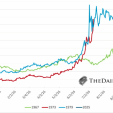US Dollar…Everyone's Problem

The U.S. DOLLAR constitutes about 60% of global reserves, 80% of global payments and almost 100% of global oil transactions, writes Jim Rickards in The Daily Reckoning.
So the Dollar's strength or weakness can have an enormous impact on global markets.
Using the Fed's broad real trade-weighted Dollar index (my favorite foreign exchange metric, much better than DXY), the Dollar hit an all-time high in March 1985 (128.4) and hit an all-time low in July 2011 (80.3).
Right now, the index is 95.2, below the middle of the 35-year range. But what matters most to trading partners and international debtors is not the level but the trend.
The Dollar is up 12.5% in the past four years on the Fed's index, and that's bad news for emerging-markets (EM) debtors who borrowed in Dollars and now have to dig into dwindling foreign exchange reserves to pay back debts that are much more onerous because of the Dollar's strength.
And EM lending has been proceeding at a record pace.
Actually, the Fed's broad index understates the problem because it includes the Chinese Yuan, where the Dollar has been stable, and the Euro, where the Dollar has weakened until very recently.
When the focus is put on specific EM currencies, the Dollar's appreciation in some cases is 100% or more.
Much of this Dollar appreciation has been driven by the US Federal Reserve's policy of raising interest rates and tightening monetary conditions with balance sheet reductions. Meanwhile, Europe and Japan have continued easy-money policies while the UK, Australia and others have remained neutral.
The US looks like the most desirable destination for hot money right now because of interest rate differentials. And that is having far-reaching consequences on EM economies.
A new EM debt crisis has already started. Venezuela has defaulted on some of its external debt, and litigation with creditors and seizure of certain assets are underway. Argentina's reserves have been severely depleted defending its currency, and it has turned to the IMF for emergency funding.
Ukraine, South Africa and Chile are also highly vulnerable to a run on their reserves and a default on their external Dollar-denominated debt.
The only issue now is whether the new crisis will be contained to Argentina and Venezuela or whether contagion will take over and ignite a global financial crisis worse than 2008.
It has been 20 years since the last EM debt crisis and 10 years since the last global financial crisis.
This new crisis could take a year to spread, so it's not too late for investors to take precautions, but the time to start is now.
The Fed's path of rate hikes and balance sheet reductions since December 2015 has reinvigorated the US Dollar, as I explained above. A stronger Dollar means weaker EM currencies in general. Again, that's exactly what we've seen lately. Right now, EM currencies are in free fall against the Dollar.
But here's a curveball question for you:
Now that the Federal Reserve raised rates again last month, is the bottom in for emerging-market currencies? And is the top in for the Dollar?
*********
Lawyer, economist, investment banker and financial author James G.Rickards is editor of Strategic Intelligence, the flagship newsletter from Agora Financial now published both in the United States and for UK investors. A frequent guest on financial news channels worldwide, he has written New York Times best sellers Currency Wars (2011), The Death of Money (2014) and The Road to Ruin (2016) from Penguin Random House.
Please Note: All articles published here are to inform your thinking, not lead it. Only you can decide the best place for your money, and any decision you make will put your money at risk. Information or data included here may have already been overtaken by events – and must be verified elsewhere – should you choose to act on it. Please review our Terms & Conditions for accessing Gold News, RSS links are shown there.

















